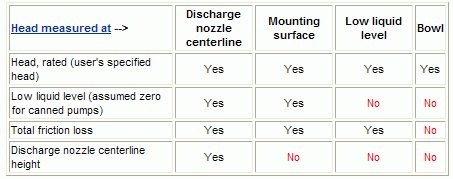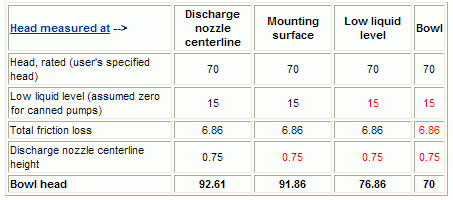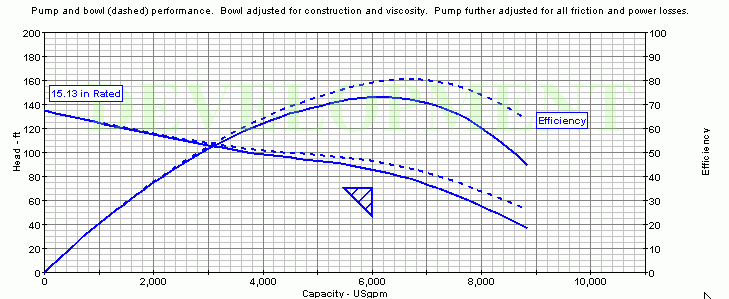
Vertical pump selection can be confusing. The confusion typically arrises as a result of inconsistent terminology and misunderstanding of the terminology. The Selector has attempted to use terminology, definitions and selection practices consistent with Hydraulic Institute standards.
This value entered here on the Conditions of Service or Performance Datasheet page represents the required head specified by the user. In addition, within the Product Line Options section the user may be able to specify where the head is measured at; discharge nozzle centerline, mounting surface, low liquid level or bowl. The duty point on the performance curve will always reflect this head (the user's specified head).
The Selector will make all vertical pump selections using the bowl head. The bowl head is calculated as described in the table below. A "Yes" indicates that the value is included when calculating the bowl head. Note that abnormally high friction values have been used in order to better describe this issue.

For example:

This value entered here on the Conditions of Service page represents the NPSH available at the suction nozzle centerline for can/barrel pumps, or the low liquid level for all other vertical pump types. The Selector will calculate the NPSH available at the first stage impeller on this basis and compare with the published NPSH required to determine acceptability.
The performance curve can show "Pump performance", "Bowl performance" or both. Use the Curve Preferences button to set the required display. The image below represents the conditions in the above tables for head measured at discharge nozzle centerline, and helps to describe what "Pump performance" and "Bowl performance" represent.
The bowl performance curve (dashed line) represents head and efficiency that has been adjusted to account for derates due to construction (stages, material of construction etc.) and viscosity. In other words, the derates were applied to the entire performance curve prior to determining an impeller diameter that would generate the required head.
The pump performance curve (solid line) represents the bowl performance further adjusted to account for friction (column, adaptor, discharge head and can) losses and power (lineshaft bearing and thrust bearing) losses. The reduced head and increased power are used to determine the pump efficiency.
Note that pump performance is not adjusted to account for static lift from any low liquid level to the discharge nozzle centerline (or wherever the user specified the head was measured at). Therefore, any static lift will result in the duty point being below the head curve.
